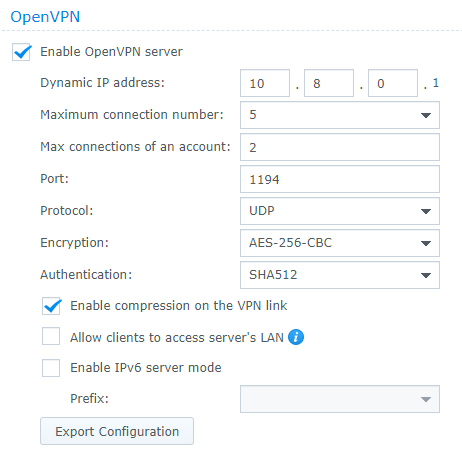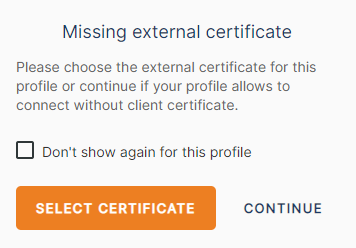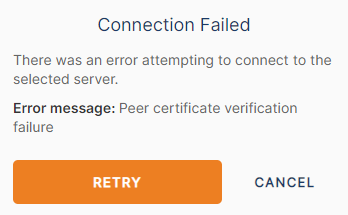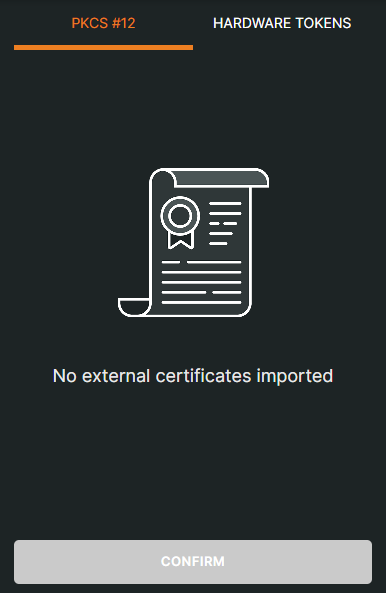
Schmill
-
Posts
148 -
Joined
-
Last visited
Posts posted by Schmill
-
-
Thanks, but all the links on that post seem to have expired as well.
I've also tried bios-mods.com which I signed up to buy I don't know if the site is still active as my account has been awaiting activation for about a week now 😞
I just can't find anywhere with active download links for the bios files.
-
Anyone have any pointers please?
-
From everything I had read this should be straight forward, but it doesn't seem to be working for me.
I already had the VPN Server installed, and I want to run an OpenVPN VPN server so that when travelling with my laptop or working away from home I can connect straight into the server.
I used the OpenVPN section of VPN Server package and largely left the defaults:

Then "Export Configuration" and change the SERVER line in the .ovpn file to match my external DNS name.
I've configured the firewall on Xpenology to allow connection to the port, and configured my router to forward connections to that port to the XPenology box.
I've then downloaded OpenVPN Connect on my Windows and imported the profile into the client.
All good so far...
Then I hit the connect button and....

If I continue without the certificate I get a Peer Certificate error:

If instead I press the "Select Certificate" button I get the "Edit Profile" dialog open, and from there the only relevant item I can see is:

If I click "Assign" then:

What step am I missing?
I feel like I am close, but I've not seen anything about this in the articles I read...
Thanks!
-
Firstly, appologies, I know I've read about this somewhere previously, but a search didn't find me anything...
I've been running my HP Microserver N54L (I think that is gen7?) for a while with 4 drives, and I want to stick a 5th in. I believe that can be done by fitting it to the optical bay, but some kind of BIOS settings / mod are required to do so?
Does anyone have a handy link to where / how to do this please? The few I've located elsewhere all seem to have expired (I know, I'm a bit late to this particular party...
 )
)
TIA!
-
-
Hi all,
I am running the N54L baremetal, currently on DSM 6.1.7-15284 (as a DS3615xs) using Juns loader 1.02b
I didn't upgrade for ages because originally it seemed that there was an issue that you couldn't use the onboard NIC, needed to use an additional intel one (or something?)
It seems maybe that isn't the case now?
What can / should I now upgrade to and what do I need to do?
I see there is a new Jun loader, but then there is talk of "redpill" as well?
There is lots of information around, but I am having trouble sorting what is relevant for me to upgrade from "where I am" to a reasonably recent form?
I'm happy dealing with most things, but I just want to make sure I get all the correct parts of Xpenology together that will work with this hardware

Any pointers gratefully received!
Thanks!
-
Yeah very relieved at that!
My panic was ransomware or something equally bad.
Must admit, I'm not entirely sure what the "data scrubbing" is, is it an integrity check / scandisk type thing?
-
It seems maybe it was doing days scrubbing on the volume; just happens it decided to do it at boot and made the poor N54L so busy that the system didn't seem to come up. 😕
A good exercise in days recovery from the SHR volume though, so there's that at least 😄
-
Thanks for the reply, no nothing in the logs.
It's not immediately after boot, it's once the local screen says that the kernel is booting, then everything goes nuts.
I've managed to mount the volume under systemrescuecd (using the same instructions) and copying files off via ethernet. Slow going but seems ok 🤞🏻
Once it's done my main files I'll try booting it again...
-
So to all intents my Xpenology box was running fine, but this morning I couldn't get any mobile apps to connect to one of the user accounts, it kept saying session timed out, login.
Using my admin account worked fine, and so I logged in and did a restart on the box.
Now starting up I can hear the drives absolutely thrashing and the system hasn't appeared back on the network.
I must admit, I've panicked somewhat since I don't know what is going on on the disks I'm loath to just "leave it".
I'm running SHR, is there some way I can check the disks outside of Synology to make sure nothing untoward is going on?
Thanks!
-
Hi, I am looking for some pointers for diagnostics please.
Microserver was running DSM 5.1 so updated to 5.2-5967 and all was well.
From there followed the tutorial to update to 6.1.4, then 6.1.7, and finally 6.1.7 update 3.
Again all was well, tried some reboots everything worked.
About 2 hrs later the DSM disappeared from the network, no web ui, no ssh.
Finally pulled the power and restarted it, still doesn't appear nor does find.synology.com see it (not that I thought it would).
So where do I go from here?
I note that Juns loader has 3 options at startup, the default first one, reinstall as a second option, and the third is a VMWare/ESXI option.
If I opt for the 2nd does that put the system back into the "migration" state and allow me to re-install 6.1.7 from .pat ?
How about volume1, is data retained (I don't want to lose it).
With the previous loaders I might have logged in on the local terminal to see what is happening, but with Juns all I see is "booting kernel" (the same as I see when it is all working)
I'm scratching my head at the moment as everything seemed fine, then its just fallen completely on it ar$e...
Thanks!
-
On 1/6/2020 at 10:57 AM, Polanskiman said:
Well I believe that tutorial I made is rather explicit on the matter and if you read you will see many people have updated their N54L. After the upgrade don't forget to delete the .xpenoboot directory that will be located in the root of your machine. Simply SSH in and delete it. That is a reminiscence of the old xpenoboot loader and will create problems if left there.
Since you are running an AMD based machine make sure you have the C1E disabled in the bios if you upgrade else it wont work.
If you decide to upgrade beyond DSM 6.2 (DSM 6.2.1) then your will also need an Intel NIC. People use the HP NC360T and works fine. Install it before the update.
I suggest reading the threads in here: https://xpenology.com/forum/forum/78-dsm-updates-reporting/
As for the above comment, all versions will have bugs and patches following discovery of the bug. This brings me again to the link posted earlier. Read this sub forum: https://xpenology.com/forum/forum/78-dsm-updates-reporting/
Much appreciated Polanskiman, really appreciate the work you've done putting it all together, I was just being overly cautious perhaps.
I've now upgraded to 6.1.7 up3 and all seems well (fingers crossed!)
Must admit, even after reading it all I didn't realise that updating to 6.2 was possible at all (without the Intel NIC), so that is worth knowing - cheers!
Sometimes I think the issue is that there is SO much info around, determining what is still relevant is tricky sometimes.
-
 1
1
-
-
Anyone able to give any pointers in the right direction please?
I want to update from 5.2, but don't want to trash my server if at all possible

-
To be honest, I think it would be a lot better if SMR drives were outlived, but it seems not...
This is what I bought, and SMR is the only thing I can think of to cause such a significant slowdown:
https://www.amazon.co.uk/Seagate-Expansion-External-PlayStation-STEB6000403/dp/B07C7V494X
Any PMR external desktop drives of ~6TB that you'd recommend as a replacement?
-
12 minutes ago, IG-88 said:
this disks usually have a xxGB area with PMR and the rest is SMR, in kind of desktop usage cases the PMR area softens the blow but using it for backup and a huge ammount of samll files (like using it with rsync) might result in lowe performance
your ~5 MB/s seem pretty low but it might depend on the backup software and just using rsync might be the worst scenario
with the right backup software and incremental backups it might be no problem but if you want it careless then spend a few bugs extra for a smr drive, it not that much
you might read this (and there are more articles about that)
https://www.storagereview.com/seagate_backup_plus_external_hard_drive_review_8tb
Thanks for the reply IG-88, is this PMR area 'visible', or is it (as I expect) hidden by the drive and only accessible / managable by it?
I am using the default "Backup & Replication" utility on the Synology software, but don't know what it uses underneath. The backup is of the entire server, so there is a mixture of large media files, as well as smaller (and plentiful!) files like mp3s, documents, and jpg photos.
I too thought that as a backup it would be ok, since the SMR wouldn't be having to do its re-write behaviour, but it seems that is not the case. Bursty writes (with associated idle times) seems file, but the constant (sequential?) writing of an large file-by-file backup seems to give it a real headache...
I did read several reviews before purchase, and all seemed to indicate that it was good for backup, bad for daily usage, but I'm wondering if by "backup" they actually meant copying a few files to it for "archive" every so often, rather than a true "tape-like" bulk backup.
-
Ok, first things first, I know SMR drives aren't intended for daily use etc. due to the way that they record data, but all that I'd read seemed to say that they were well suited as backup drives.
So I have a Seagate Expansion Desktop 6TB drive (USB3 connected, and externally powered) running through a USB3 card to backup my DSM 5.2 system... but it is horrendously slow.
As in I started the backup over 38 hours ago, and so far it has managed to backup (DATA backup, not LUN) just 585 GB.
I am using an N54L as my hardware platform - but is there any issue with the 5.2 software using SMR drives? It works fine with other USB3 drives (so I know its not the interface card), but I suspect that they are PMR, so does the OS having any issues with SMR, or is it literally going to be down to the drive itself? (In which case I'll have to return it and purchase a much more expensive alternative
 )
)
Thanks for any info!
-
It seems more and more that attacks are targetting home / small-office NAS setups.
In light of this (and https://www.synology.com/de-de/security/advisory/Synology_SA_19_37 ) , has there been any movement on this?
I like being able to eject my backup media after the backup completes, but would also like to be able to re-insert (?) it just before the next backup is due to start.
-
In light of this post:
https://xpenology.com/forum/announcement/23-multiple-vulnerabilities-dos-attacks/
The Synology page states:
QuoteAbstract
Multiple vulnerabilities allow remote authenticated users to execute arbitrary commands or conduct denial-of-service attacks, or allow remote attackers to delete arbitrary files via a susceptible version of DiskStation Manager (DSM).
Affected Products
Product Severity Fixed Release Availability DSM 6.2 Important Upgrade to 6.2.2-24922-4 or above. As it only lists 6.2, does that mean that 6.1 is not affected?
I am interested to know, since it seems with N54L "original hardware" (i.e. onboard NIC) we are stuck at 6.1.x - so is this an issue for us?
Thanks!
-
I've been running an N54L as a DS3615xs on 5.2 5967 Update 9 using SHR for quite some time, since when I was looking before the upgrades to 6.anything seemed flakey at best.
Now I'm looking to update, but I'm not sure what 'end goal' I should be aiming for, or if I have to take an intermediate steps along the way?
From what I can make out, the post below will allow me to upgrade from my 5.2 to 6.1.7 relatively pain-free?
However, I'm not sure if then I should be upgrading again, or indeed (if that is the case) whether I should be going straight from 5.2 to something later than 6.1.7?
6.1.7 seemed to be the most stable, but then I wasn't sure about this:
https://www.synology.com/de-de/security/advisory/Synology_SA_19_37
Do need to go to 6.2 for cybersecurity reasons?
Thanks for any pointers that can be given - I've been away for far too long!
-
- Outcome of the installation/update: SUCCESSFUL
- DSM version prior update: DSM 5.2-5967 Update 8
- Loader version and model: XPEnoboot 5.2-5967.1 DS3615xs
- Using custom extra.lzma: NO
- Installation type: BAREMETAL - HP Microserver N54L
-
 1
1
-
-
Great thread, I am running (and have been for quite some time) DSM 5.2-5967 Update 6 , and got tripped up by this latest Plex update too.
I guess there will now be a whole bunch of us looking to update to DSM 6 ? 😲
-
Hi all, what bootloader are people running with this latest update please?
-
OK cheers, on the Tapatalk app there is no link in your first post, but the Amazon link does show.If you click the link, you'll see this: https://www.amazon.co.uk/gp/product/B01C86K4IG/ref=oh_aui_detailpage_o01_s00?ie=UTF8&psc=1
Thanks again!
Sent from my MotoG3 using Tapatalk
-
"this one" ?This one works in DSM 6.0, but i only use it to connect my UPS. I cannot tell you the performance.
Sent from my MotoG3 using Tapatalk
N54L - Using Optical bay for 5th drive
in Hardware Modding
Posted
Thanks but even that page just says "an error has occurred" 😭